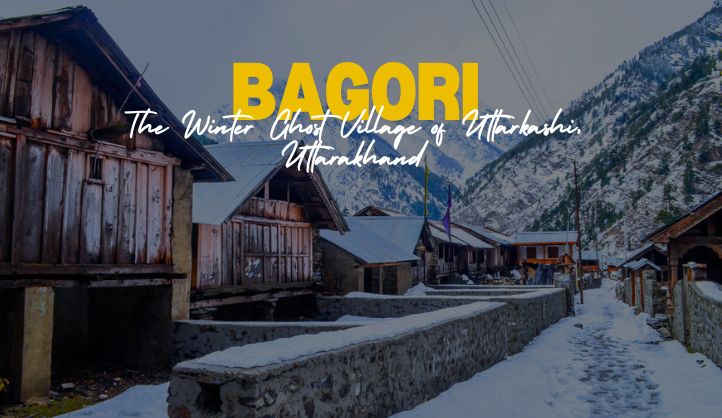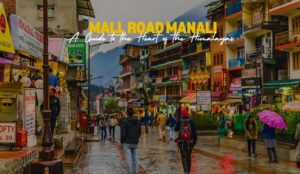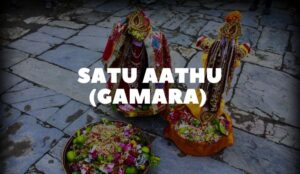A Tale of Snow and Solitude
Deep in the heart of the Himalayas, nestled amidst towering peaks and pristine glaciers, lies a village shrouded in mystery and intrigue. It’s a place where time seems to stand still, and the silence is broken only by the howling wind and the occasional rumble of an avalanche. Welcome to Bagori, the winter ghost village of Uttarkashi, Uttarakhand.
Bagori is a small hamlet located in the Chinyalisaur block of Uttarkashi district. It’s a remote place, inaccessible for most of the year due to heavy snowfall. The village is surrounded by dense forests and snow-capped mountains, making it a breathtakingly beautiful but challenging place to live.
Bagori is a narrow village with approximately 150 wooden houses, many of which are slowly being replaced by modern concrete structures. However, the village still retains much of its traditional charm. To reach Bagori, you’ll need to pass through Harsil and cross three small bridges. During the winter months, the village becomes completely deserted, leaving behind only the eerie sounds of the Buddhist monastery bell and the howling wind. A short walk through the empty streets can be a chilling experience, as you’ll see locked houses, hear the constant ringing of bells, and feel the biting wind.
How to Reach
- Nearest Airport: The nearest airport is Dehradun, which is well-connected to major cities in India.
- Nearest Railway Station: Rishikesh is the nearest railway station.
- Road Journey: From Dehradun or Rishikesh, you can take a bus or hire a taxi to Uttarkashi. The journey to Uttarkashi takes approximately 4-5 hours.
- Local Transport: From Uttarkashi, you can hire a local taxi or jeep to reach Harsil, a small town located on the way to Bagori.
- Trekking: The final leg of the journey to Bagori involves a trek of approximately 10-12 kilometers. The trek is moderate and offers stunning views of the Himalayas. However, it can be challenging during the winter months due to heavy snowfall.
Best Time to Visit
The best time to visit Bagori is during the summer months (May to October) when the weather is pleasant and the village is accessible. During this time, the snow melts, making it easier to reach Bagori and enjoy the surrounding natural beauty.
Here’s a breakdown of why summer is the ideal time to visit:
- Pleasant Weather: The summer months offer comfortable temperatures, making it enjoyable to explore the village and its surroundings.
- Accessibility: The roads leading to Bagori are more accessible during the summer, allowing for easier transportation.
- Natural Beauty: The village and its surroundings are at their most beautiful during the summer when the snow melts and the greenery comes alive.
- Fewer Crowds: It is a relatively less-known destination, so you’re likely to encounter fewer crowds during the summer months compared to peak tourist seasons.
A Winter Wonderland
As winter sets in, Bagori is transformed into a winter wonderland. The entire village is blanketed in snow, and the air is crisp and cold. The locals, who are primarily farmers and herders, prepare for the long winter months by stocking up on food and firewood.
When the snow falls, It becomes a ghost town. The villagers retreat to their homes, huddled around their fireplaces, trying to stay warm. The only sounds are the crackling of the fire and the occasional creak of the wooden houses.
The Ghost Stories
The isolation and eerie silence of Bagori have given rise to many ghost stories. Locals talk about strange lights seen in the sky, ghostly figures wandering the snow-covered streets, and unexplained noises echoing through the deserted village.
One popular story tells of a young woman who was left behind by her lover. Heartbroken, she wandered into the mountains and was never seen again. Some say her ghost still haunts the village, searching for her lost love.
Another story involves a group of travelers who were caught in a blizzard and sought shelter in an abandoned house. When they tried to leave, they found the doors and windows locked from the inside. Desperate and terrified, they huddled together until the storm passed. When they finally managed to escape, they realized they were the only survivors.
A Challenging Life
Despite the challenges of living in such a remote and harsh environment, the people of Bagori are resilient and resourceful. They have adapted to their surroundings and developed unique ways of coping with the harsh winters.
They rely on traditional farming techniques and raise livestock for their livelihood. They also harvest medicinal herbs and other forest products, which they sell to supplement their income.
A Tourist Destination
In recent years, Bagori has become a popular tourist destination. Visitors are drawn to the village’s natural beauty, its unique culture, and its mysterious atmosphere.
There are several trekking trails in the area, leading to stunning viewpoints and glacial lakes. Visitors can also experience the local lifestyle by staying in homestays and participating in village activities.
A Future Uncertain
Despite its growing popularity, Bagori faces many challenges. Climate change is affecting the region, leading to unpredictable weather patterns and melting glaciers. This poses a serious threat to the village’s water supply and agricultural activities.
The government has implemented several conservation programs to protect the environment and support the local community. However, the future of the town remains uncertain.
Nearby Attractions to Visit from Bagori, Uttarakhand
The town offers a serene and picturesque experience. If you’re exploring this region, here are some nearby attractions worth visiting:
Gangotri National Park
Gangotri National Park is home to the Gangotri Glacier, the source of the Ganges River. It’s a paradise for trekkers and nature lovers, offering stunning landscapes and diverse flora and fauna.
Valley of Flowers National Park
Renowned for its vibrant wildflowers, this UNESCO World Heritage Site is a must-visit for nature enthusiasts. The park is especially beautiful during the summer months when the flowers bloom.
Kedarnath Temple
Kedarnath Temple is an ancient Hindu temple dedicated to Lord Shiva and is one of the Char Dham pilgrimage sites. The temple is situated amidst breathtaking mountain scenery and attracts devotees from all over the world.
Mandakini River
Mandakini River is a scenic river that flows through the region and offers opportunities for rafting, kayaking, and fishing.
Uttarkashi
Uttarkashi is a town known for its spiritual significance and is home to several temples and ashrams. You can explore the local markets, visit the Vishwanath Temple, or simply soak in the peaceful atmosphere.
Harsil
Harsil, a picturesque village is located on the way to Bagori and offers stunning views of the surrounding mountains. You can enjoy local cuisine, explore the nearby temples, or take a leisurely stroll through the village.
Conclusion
Bagori is a fascinating and mysterious place. It’s a testament to the human spirit and the ability of people to adapt to challenging environments. Whether you’re interested in nature, culture, or the supernatural, Bagori has something to offer.
FAQs about Bagori, Uttarakhand
1. What is Bagori famous for?
Bagori is famous for its remote location, breathtaking natural beauty, and unique culture. It’s often referred to as a “ghost village” during the winter months due to its isolation and the absence of most residents.
2. When is the best time to visit Bagori?
The best time to visit Bagori is during the summer months (May to October) when the weather is pleasant and the village is accessible.
3. How can I reach Bagori?
The nearest airport is Dehradun, and the nearest railway station is Rishikesh. From there, you can take a bus or taxi to Uttarkashi, and then hire a local taxi or jeep to reach Harsil. The final leg of the journey involves a trek of approximately 10-12 kilometers.
4. What are the accommodation options in Bagori?
Accommodation options in Bagori are limited and often include homestays, guesthouses, and camping.
5. What are the things to do in Bagori?
Some popular activities in Bagori include trekking, exploring the surrounding natural beauty, visiting the local Buddhist monastery, and interacting with the local community.
6. Is Bagori safe to visit?
Bagori is generally a safe place to visit, but it’s always a good idea to exercise caution and follow local guidelines.
7. What should I pack for a trip to Bagori?
For a trip to Bagori, you should pack warm clothing, comfortable hiking shoes, rain gear, a hat, sunscreen, and essentials for camping if you plan to stay in a tent.
8. Are there any local festivals or events in Bagori?
Bagori may have local festivals or events, but information on these can be limited. It’s best to check with local authorities or tourism agencies for the latest updates.
9. What are the local customs and traditions in Bagori?
The local people of Bagori follow traditional customs and traditions, which may include religious practices, agricultural rituals, and community gatherings.
10. Are there any nearby attractions or places to visit from Bagori?
Yes, there are several nearby attractions, including the Gangotri National Park, Valley of Flowers National Park, and the Kedarnath Temple.





